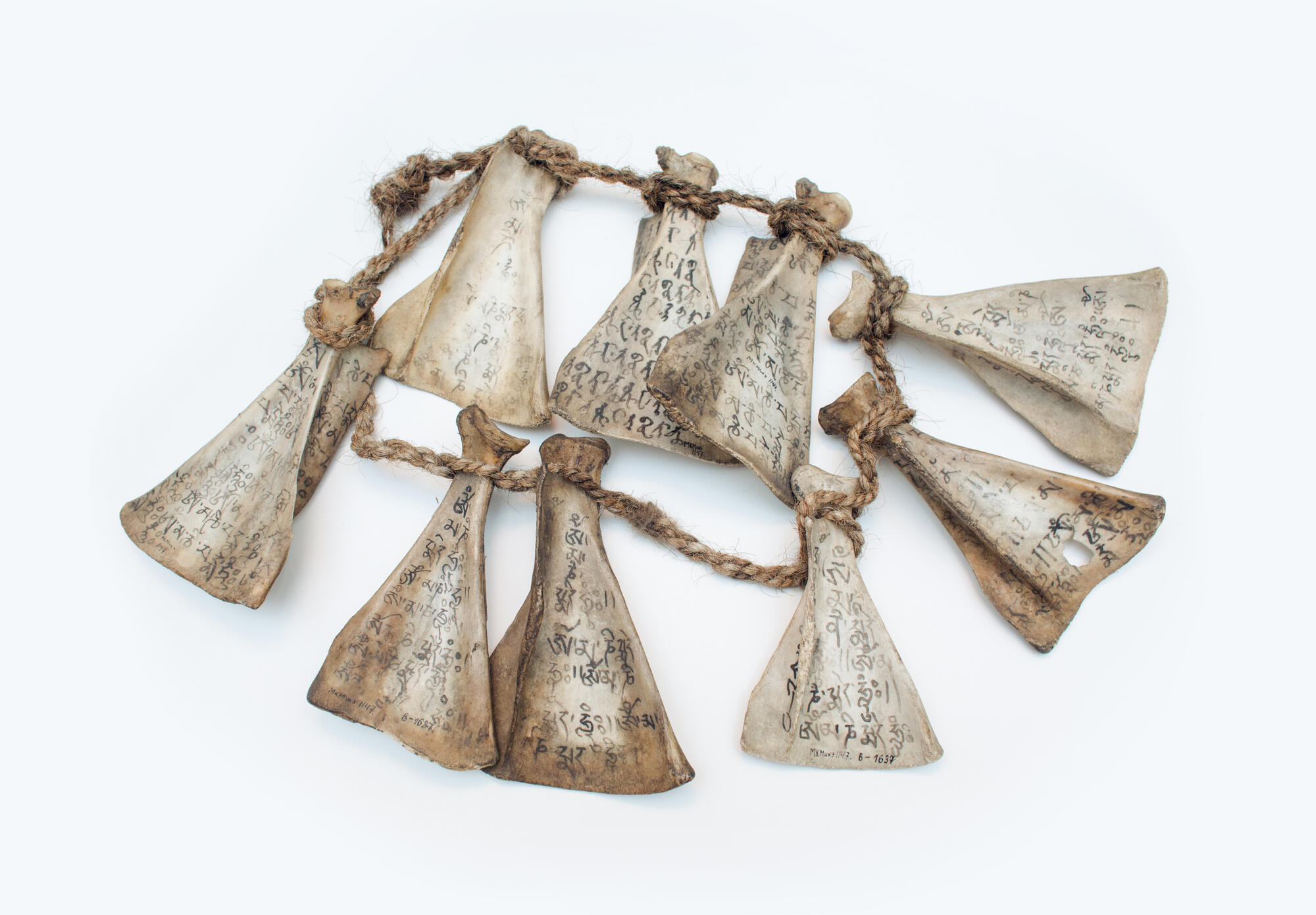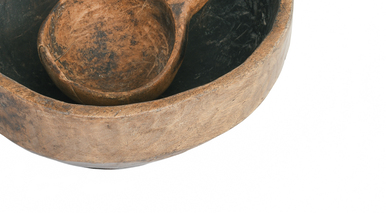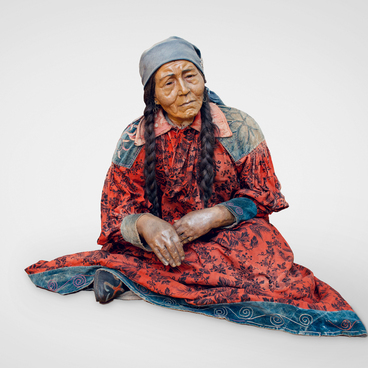In the 18th century, Tibetan Buddhism from Mongolia spread widely among the Turkic-speaking population in Tuva and had a great influence on the system of religious beliefs of Tuvans.
One of the most famous Buddhist mantras, the sacred religious texts ‘Om mani padme hum, ” is kept in the museum’s collection. The item entered the museum’s collection in 1900. The mantra is inked on nine ram bones: eight in Tibetan and the ninth in Old Mongolian. The bones are tied together with a cord that is woven from horsehair.
The mantra “Om mani padme hum” refers to Mahayana, one of the two main branches of Buddhism. Mahayana Buddhism emerged in India and from there spread to other Asian countries: China, Tibet, Nepal, Mongolia, and others.
Mahayana is a body of religious teachings for those who follow the Way of the bodhisattva, an enlightened being who has chosen to renounce rebirths and seek awakening for the good of all other beings. This is why this same teaching is sometimes called Bodhisattvayana.
The word “mantra” itself came from Sanskrit. It consists of the root “man”, which translates as “to think, ” and the suffix “tra”, denoting an instrument. Literally, “mantra” translates as “tool of thought”. Sacred texts were usually read during meditation. It was believed that the one who repeated them fell into a special state of consciousness — trance. And this makes it possible to achieve inner harmony.
The mantra “Om mani padme hum” has many meanings and interpretations, many of which have been described in a book by Tibetan Buddhism researcher Anagarik Govind.
Each part of the mantra has a different translation. Om refers to Brahma, the Hindu god of creation. Brahma was considered simultaneously existing and non-existent, revealed and unrevealed, like the entire universe, the creator of the higher and the lower. Mani is a crystal or gemstone, “padme” is a lotus, and “hum” denotes the heart.
Therefore, the mantra was thought to be understood as the phrase “The whole universe is like a jewel or crystal located in the center of my heart or in the core of the lotus, which is me; it is manifested, it glows in my heart.”
According to one version, the mantra bestows purity of body, speech, and mind of the Buddha to the one who recites it. According to another, it brings abundance and prosperity. In Tibetan practice, it was believed, that the meaning of the mantra should be spelled out: “Om” cleanses from pride and conceit, “Ma” removes envy and jealousy, “Ni” frees from attachment and selfish desires, “Pad” dispels ignorance, “Me” dissolves greed, and “Hum” transforms hatred into creation.
One of the most famous Buddhist mantras, the sacred religious texts ‘Om mani padme hum, ” is kept in the museum’s collection. The item entered the museum’s collection in 1900. The mantra is inked on nine ram bones: eight in Tibetan and the ninth in Old Mongolian. The bones are tied together with a cord that is woven from horsehair.
The mantra “Om mani padme hum” refers to Mahayana, one of the two main branches of Buddhism. Mahayana Buddhism emerged in India and from there spread to other Asian countries: China, Tibet, Nepal, Mongolia, and others.
Mahayana is a body of religious teachings for those who follow the Way of the bodhisattva, an enlightened being who has chosen to renounce rebirths and seek awakening for the good of all other beings. This is why this same teaching is sometimes called Bodhisattvayana.
The word “mantra” itself came from Sanskrit. It consists of the root “man”, which translates as “to think, ” and the suffix “tra”, denoting an instrument. Literally, “mantra” translates as “tool of thought”. Sacred texts were usually read during meditation. It was believed that the one who repeated them fell into a special state of consciousness — trance. And this makes it possible to achieve inner harmony.
The mantra “Om mani padme hum” has many meanings and interpretations, many of which have been described in a book by Tibetan Buddhism researcher Anagarik Govind.
Each part of the mantra has a different translation. Om refers to Brahma, the Hindu god of creation. Brahma was considered simultaneously existing and non-existent, revealed and unrevealed, like the entire universe, the creator of the higher and the lower. Mani is a crystal or gemstone, “padme” is a lotus, and “hum” denotes the heart.
Therefore, the mantra was thought to be understood as the phrase “The whole universe is like a jewel or crystal located in the center of my heart or in the core of the lotus, which is me; it is manifested, it glows in my heart.”
According to one version, the mantra bestows purity of body, speech, and mind of the Buddha to the one who recites it. According to another, it brings abundance and prosperity. In Tibetan practice, it was believed, that the meaning of the mantra should be spelled out: “Om” cleanses from pride and conceit, “Ma” removes envy and jealousy, “Ni” frees from attachment and selfish desires, “Pad” dispels ignorance, “Me” dissolves greed, and “Hum” transforms hatred into creation.



